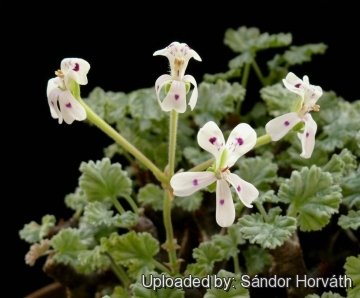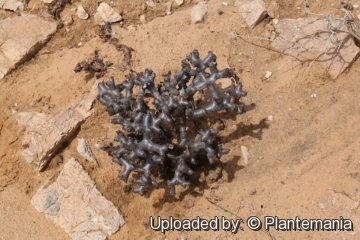




Your support is critical to our success.
- Encyclopedia of SUCCULENTS
- Encyclopedia Index
- Families
- Genera
- Species
- Geraniaceae
- Pelargonium
- Caudiciforms
Since 4 Aug 2013
Accepted Scientific Name: Pelargonium crassicaule L'Hér.
Geraniologia , t. 26 1787 L'Hér.

Origin and Habitat: Pelargonium mirabileSN|32396]]SN|32397]] occurs inland into the southern Namib Desert of Namibia in the vicinity of the settlement of Luderitz. The similar and strictly related Pelargonium cortusifolium and Pelargonium crassicauleSN|32397]]SN|32396]] prefer more coastal desert areas near the Orange River mouth.
Habitat and ecology: This species occurs on inselbergs in the southern Namib Desert of Namibia together with numerous endemic species, like, e.g., Microloma penicillatum, Cynanchum meyeri, and Lessertia acanthorhachis, all of which are associated with rocky habitats, while the surrounding plains are often dominated by grasses or annuals, in large parts also by the stem-succulent Euphorbia gummifera. This region is extremely arid, the yearly rainfall is only 25-50 mm, and day temperatures soaring near 40 degrees Celsius. There are no shrubs to supply it with shade. It must live out its life amongst rocks and loose sand which seems forever on the move. For weeks on end there may be fierce winds, and the plants are subject to the destructive force of frequent sandstorms.
Synonyms:
- Pelargonium mirabile Dinter
Pelargonium crassicaule L'Hér.
Geraniologia , t. 26 1787
Synonymy: 2
- Pelargonium crassicaule L'Hér.
- Pelargonium mirabile Dinter
ENGLISH: Admirable Stork's-bill
Description: Pelargonium mirabileSN|32396]]SN|32397]] is a fleshy species with shiny dark brown bark and forming bushes rarely more than 30 cm tall, but to 65 cm in diameter with hundreds of succulent to woody finger like branches. It is very closely related to Pelargonium crassicaule and perhaps only a form of it. It differs from the above by its much thinner (about the size of a pencil), more richly branched shoots and soft grey green leaves with a cuneate leaf base. Its coral-like branching pattern is unique in the genus. For most of the year it is a leafless, but after the rains have fallen it is rapidly transformed into a green-leaved bush and shortly followed by numerous trusses of white to pale pink flowers with cherry blotches on all petals and dotted veins on upper petals.
Stems: Frutescent very much branched. Main stem very short up to 4 cm in diameter. Branches 1-2 cm long and 6-8(-12) mm in diameter, spreading so as to form а thick spreading bush and the whole plant can raise to 30 centimetres and 60 cm in diameter. The branches are very dark in appearance shiny red-brown to dark grey-brown, thickly clothed with woolly hairs as are the petioles peduncles and calyx. The bark is rich in a wax material, which is inflammable.
Leaves: Smallish, deciduous in summer. Lamina with (usually) a cuneate leaf base (to distinguish it from Pelargonium crassicauleSN|32396]]SN|32396]]), toothed with rigid teeth that vary considerably in size, silvery in appearance, grey green, soft, very variable hairy on both sides. Lower leaves cordate some nearly round and not lobed others 3 lobed and some inclining to be 5 or 7 lobed bluntish strongly nerved with numerous nerves underneath, upper ones wedge shaped or ovate acute more or less tapering to the base scarcely lobed. Petioles short flat on the upper side and convex below a little widened at the base. Stipules varying from lanceolate to ovate taper pointed sometimes more or less toothed hairy, fringed and becoming woody.
Inflorescences: 4 to 12 flowered umbels. Peduncles short and stout cylindrical.
Flowers: Almost identical to Pelargonium cortusifolium and Pelargonium crassicauleSN|32397]]SN|32396]]. Calyx 5 cleft. Petals white, pale pink or mauve, with cherry blotches on all petals and dotted veins on upper petals, the upper 3 larger than lower 3. Fertile stamens 7.
Bibliography: Major references and further lectures
1) Sweet, Robert “Geraniaceae : the natural order of gerania, illustrated by coloured figures and descriptions, comprising the numerous and beautiful mule-varieties cultivated in the gardens of Great Britain, with directions for their treatment” London :Printed for James Ridgway, Piccadilly, No. I [-XXIV] of the Second Series, Volume 1828
2) Eggli, U., ed. “Illustrated handbook of succulent plants: Dicotyledons”. 2002
1) "The Greenhouse: A Quarterly Review for All Gardeners", Volume 8 P. Langfield & Company, 1963
2) Werner Rauh “The Wonderful World of Succulents: Cultivation and Description of Selected Succulent Plants Other Than Cacti” Smithsonian Institution Press, 1984
3) Stefan Porembski, W. Barthlott “Inselbergs: Biotic Diversity of Isolated Rock Outcrops in Tropical and Temperate Regions” Springer Science & Business Media, 06 December 2012
4) Geranium Society “The Geranium Year Book” Geranium Society, 1954

Pelargonium mirabile Photo by: Sándor Horváth

Pelargonium mirabile in habitat. Photo by: © Plantemania
Cultivation and Propagation: Easily growing in cultivation. Pelargonium mirabileSN|32394]]SN|32397]] is in cultivation locally and in botanic gardens. Seeds from ripe fruits germinate freely and new plants can be raised in greenhouses.
It is summer dormant.
Soil: It does best with a mix that has almost no organic material at all. Perlite can be substituted for pumice, but it tends to rise to the surface of the mixture.
Water requirements. Water from early February to late April, then from early August to late November, at a minimum temperature of +14° C. Keep completely dry in summer and rather dry winter, at a minimum temperature of +8° C. Pelargonium cotyledonisSN|32397]]SN|32394]] in cultivation is usually so overwatered and overfertilized that it is hardly recognizable as the species that it is. Correctly grown, this is a beautiful, compact and dense plant.
Exposure: Light shade or morning sun in summer.
Frost Tolerance: Tender, it needs frost protection. Recommended minimum temperature is 8 °C or even above. Protect from frost.
Reproduction: There are two main ways to propagate members of the genus Pelargonium. Plant seeds any time of the year, but a spring or autumn sowing of seeds is usually most successful. Rooting cuttings of stems is another method.
| Your Actions | |
|---|---|
| Back to Pelargonium index | |
| Back to Geraniaceae index | |
 |
Back to Succulents Encyclopedia index |
Privacy stantement - Terms and conditions - How to cite - About us - Feedback - Donate



